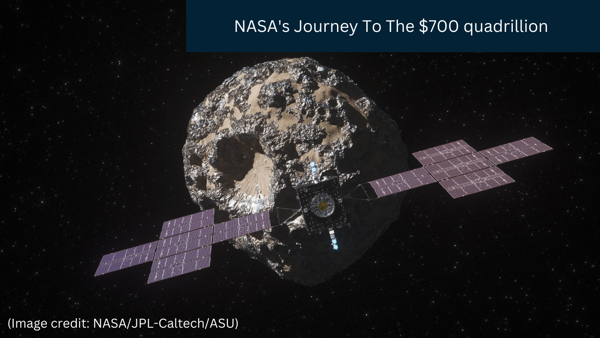
Science & Space
The NASA's Incredible Psyche Mission : Visit To The $700 Quintillion Asteroid World
NASA, the world's largest and most advanced space research facility, will send the spacecraft to the trillion-dollar asteroid world, named after that specific asteroid.
The asteroid's name is 16-Psyche, and it is an M-type asteroid. The asteroid is located between Mars and Jupiter in the main asteroid belt.
16-Psyche is not a rocky asteroid; it is entirely composed of metals, some of which are extremely valuable while others are inexpensive. 85% Iron, nickel, and 15% Silicate make up the world. As the world is fully made of metals which is why the cost of the metal world is around 700 to 1,000 quadrillions US dollars, According to NASA scientists.
The asteroid's diameter is 140 miles or 226 kilometers, which was determined by the Infrared Thermal Emission Satellites' Infrared emission technique and it takes 5 earth years, or 1,525 days, to complete one revolution around the sun. The asteroid's day length is approximately 4.2 hours, Which is popularly known as "Psche Day". The length of the object's day is determined by its rotation on its own axis.
The mass of the 19-Psyche is only 1% of earth's satellite, the Moo tn. The discovery of the asteroid was done by Italian astronomer Annibale de Gasparis on March 17, 1852. The naming of the asteroid is not an exception in this case too, the asteroid is named after the Greek Goddess of the soul, who was mortal and married to the Roman God of Love, Eros.
The 16-Psyche's distance from the sun is 2.5 to 3.3 AU, and 1AU is equal to the distance between the sun and earth. That means the asteroid's distance from the sun is ranging from 235 million to 309 million miles or 378 million to 497 million kilometers.
Psyche was observed 9 times by various agencies, and conclusive data was collected between those observations, which took place between 2004 and 2019.
Because of its full metal composition, the Psyche is a fairly heavy asteroid, with masses ranging from 2.3e+19 kg to 5.8e+19 kg. According to the most recent models, Psyche has the shape of a Jacobi ellipsoid, and its dimensions are within a few kilometers of 278 km x 238 km x 171 km.
According to NASA scientists, the 16-Psyche is the remnant of the core of a protoplanet. The protoplanet may have been destroyed at the inception of the solar system's formation.
NASA's Proposed Journey:
NASA will send spacecraft to 16-Psyche to explore the most expensive known asteroid in the solar system. By doing so, NASA hopes to find answers to some unanswered questions, such as what the core is made of and whether 16-Psyche is the remnant of a protoplanet.
No spacecraft has ever visited the most expensive world until now. In 2014, NASA proposed its Psyche mission under NASA's discovery program, which is a solar system exploration mission of NASA funded through its "Planetary Mission Program".
Despite its proposal in 2014, the mission was approved on January 4, 2017. The launch is proposed for October 2023, with gravity assistance from Earth in 2024, Mars gravity assistance in 2025, and arrival at the asteroid in 2030. However, the program has already been delayed due to COVID-19 disruption and the supply chain crisis.
NASA, already published the design and making of the Psyche spacecraft on December 8, 2022, from "Astrotech Space Operations Facility" near "Kennedy Space Station", Florida. Psyche spacecraft will be launched using the SpaceX Falcon Heavy Rocket.
Psyche spacecraft consists of Multispectral Imager, Gamma-Ray-neutron spectrometer, antenna for data transfer, and radio instrument for gravity measurement. Researchers will be studying the asteroid by using those instruments.
NASA is collaborating with its partners to make this mission possible. The partners are:
1. Applied Physics Laboratory (APL)
2. Arizona State University (ASZ)
3. Deutsches Zentrum fur Luft-und Ramfahrt (DLR)
4. Jet Propulsion Laboratory (JPL)
5. Lawrence Livermore National Laboratory (LLNL)
6. Massachusetts Institute of Technology (MIT)
7. Malin Space Science Systems (MSS)
8. Planetary Science Institute (PSI)
9. Technical University of Denmark (DTU)
10. Southwest Research Institute (SwRI)
11. the University of California Los Angeles (UCLA)
and other partners are all contributing to this project.
How would 16 Psyche be capable of destroying the global economy if mining began?
The total value of the world economy is 85.239 trillion US dollars and in comparison to it, the Psyche's value is massive 700 to 1,000 quintillion US dollars. If human being will start mining the Psyche today the price of the available metal on the earth will be reduced to almost zero which will decimate the industries related to those metals.
And the countries that have the metals will have their economies destroyed and their populations will be decimated due to hunger and civil war. Chile, for example, has an abundance of copper, and if Psyche is mined, the Chilean economy will suffer, and those employed in that industry will lose their jobs.
As a result, nations planning to mine asteroids must consider the welfare of others and should not do anything that will harm an entire nation. Hopefully, larger-scale mining is in pipeline now, and several experiments are currently underway. Extra metals or resources will be required in the near future to feed the world's exponentially growing population. Japan's Hayabusa probe to asteroid 25143 Itokawa is one example of an asteroid sampling return technique for future mining.

0 Comments